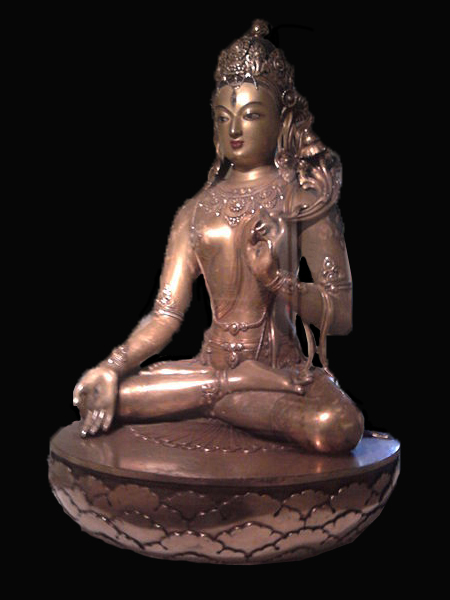Seated Bodhisattva Tara Images
Tārā probably originated as a Hindu goddess and is still worshipped in some Hindu traditions. She is worshipped as a female bodhisattva in Mahayana and especially Tantrayana Buddhism. The Shailendra Dynasty had converted to Mahayana Buddhism during the reign 760 to 775 CE. It appears that the Hindu King Panangkaran, the ruler of the Mataram Kingdom from 760 to 775 CE, and successor of Sri Sanjaya was persuaded by the Guru of the Shailendra family to allow the construction of the Buddhist Candi Kalasan. A prasasti, written in Sanskrit using Early Nagari script and dated 778 CE, states that the temple was constructed as a holy building for the Bodhisattvadevi Tara. According to the inscription, the temple once housed a very large statue of the Boddhisattvadevi Tara. By the design of the throne, the statue of the goddess was probably in a seated position and made from bronze.
It is not surprising that with the flourishing of Hindu and Buddhist religions side by side in Java and the syncretism that took place, that Devi Tara or Bodhisattva Tara had a special place and was widely revered. Although the Buddhist tradition in Java during that period is usually described as Mahayana, the importance of Tara points to the syncretism with Hinduism and the tantric influences suggest that a better description might be Vajrayana. In the case of Tara, a comparison may be made with Tibet, where Tara is indeed a very important bodhisattva. The numbered images are part of the Apsarah Gallery Collection.
Mongolian Bodhisattva Tara
 Material: bronze.
Material: bronze.
Patina: rosy-copper, perhaps a very high copper content alloy.
Posture: padmasana.
Seated on a lotus throne with the right hand showing the varada mudra, the left hand the vitarkamudra and a lotus on the left shoulder. This is the typical posture of the White Tara.
Dated from the 17th century.
Exquisite detail and finish.
Javanese Bodhisattva Tara
 Material: gold image on a silver vishvapadma and socle.
Material: gold image on a silver vishvapadma and socle.
Patina: silver parts have dark brown-grey patina.
Posture: padmasana.
Seated on a lotus throne with hands in the dhyanamudra.
This is the typical posture of the White Tara.
Dated from the 9th century.
1. Bodhisattva Tara
 Material: bronze.
Material: bronze.
Patina: brownish green.
Posture: ardhapadmasana, but there is no lotus pedestal. Probably the figurine was originally on a separate lotus pedestal.
A typical posture of the Green Tara.
The right hand shows varadamudra and the left hand shows the vitarkamudra.
2. Bodhisattva Tara
 Material: bronze.
Material: bronze.
Patina: brownish green.
Posture: ardhapadmasana, on a vishvapadma lotus pedestal. A typical posture of the Green Tara.
The right hand shows the vitarkamudra and the right hand padmapani holding the stem of the lotus.
3. Bodhisattva Tara
 Material: bronze.
Material: bronze.
Patina: brownish green.
Posture: ardhapadmasana, on a vishvapadma lotus pedestal. A typical posture of the Green Tara.
The right hand shows the vitarkamudra and the right hand padmapani holding the stem of the lotus
4. Bodhisattva Tara
 Material: bronze.
Material: bronze.
Patina: brownish green.
Posture: lalitasana, on a vishvapadma with right foot on a lotus. A typical posture of the Green Tara.
The right hand shows varadamudra and the left hand padmapani holding the stem of the lotus.
5. Bodhisattva Tara
 Material: bronze.
Material: bronze.
Patina: very dark brown.
Posture: lalitasana, on a vishvapadma with right foot on a lotus. A typical posture of the Green Tara.
The right hand shows varadamudra and the left hand padmapani holding the stem of the lotus.
6. Bodhisattva Tara
 Material: bronze.
Material: bronze.
Patina: dark brown.
Posture: lalitasana, on a vishvapadma with right foot on a lotus.
Note the elaborate crown with what looks like three feathers and fine detail on this tiny figurine.
The right hand shows varadamudra and the left hand padmapani holding the stem of the lotus and lotus on the left shoulder.
Attributes: trisula behind each shoulder. The trisula is an attribute of Durga and Parvati the consorts of Shiva and also of Avalokitesvara, but the female aspect with the lotus and the mani suggests that it is the Green Tara.
The audio clip below is the Sanskrit mantra dedicated to the Boddhisattva the Green Tara and is chanted by His Holiness the Dalai Lama.
![]()
The mantra in Sanskrit is Oṃ tāre tuttāre ture svāhā. The Tibetan pronunciation of the last word is soha.